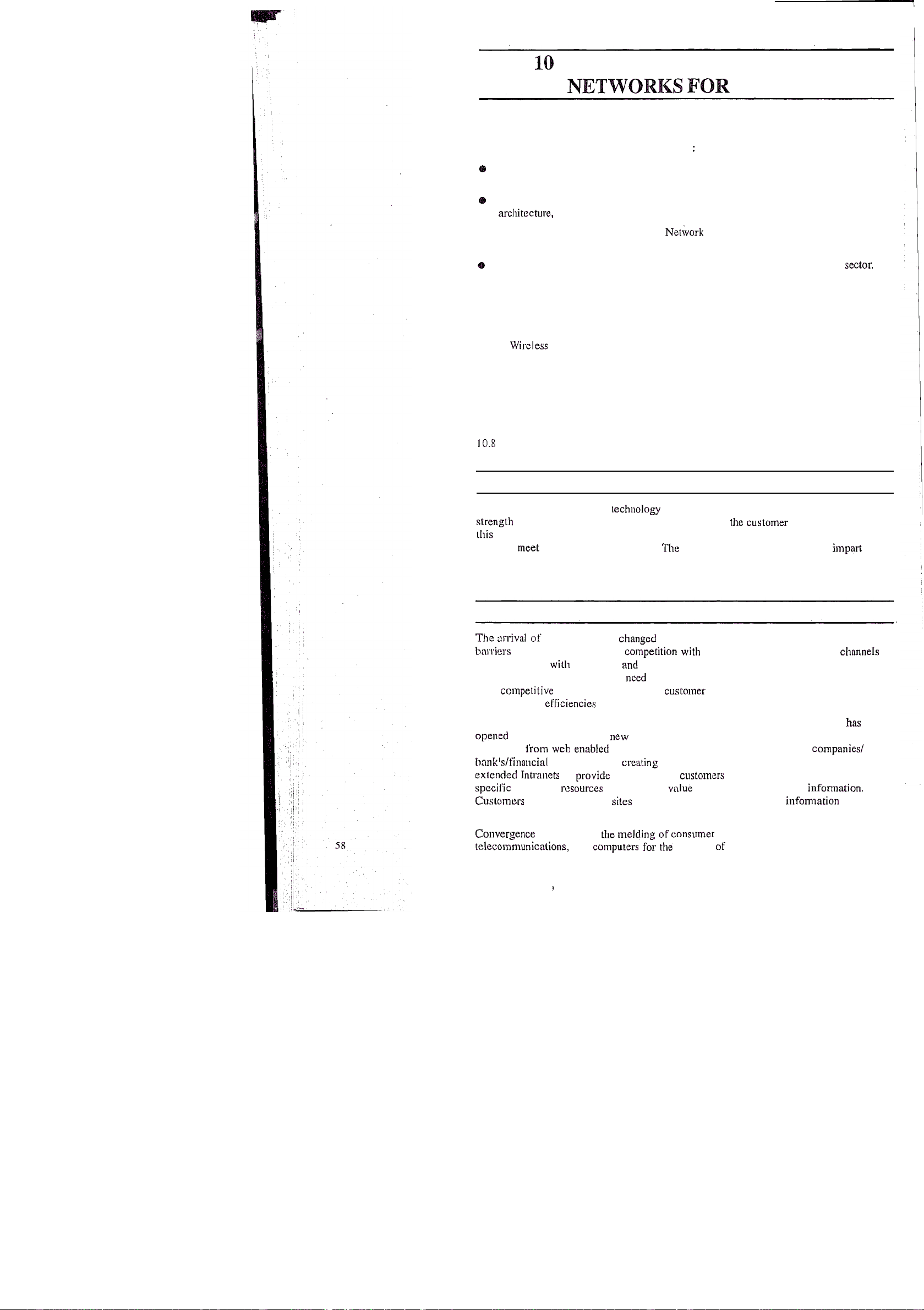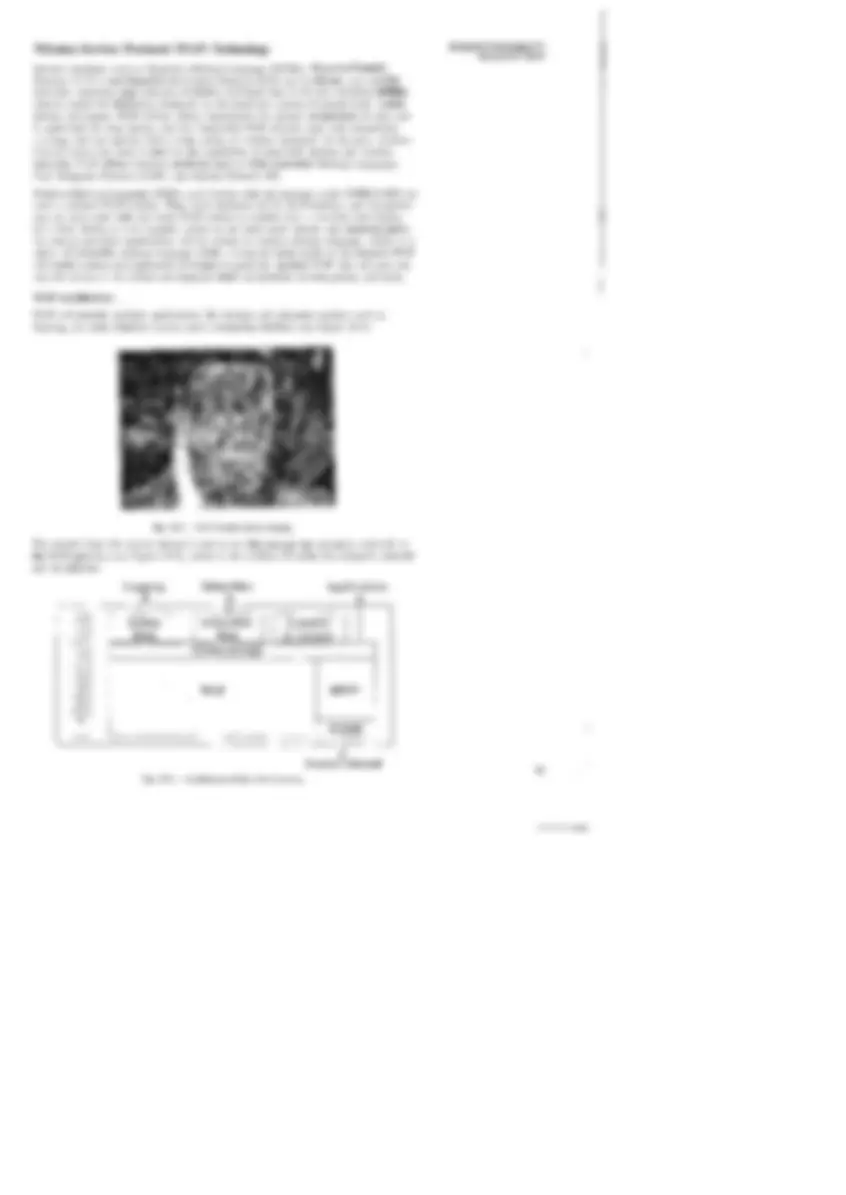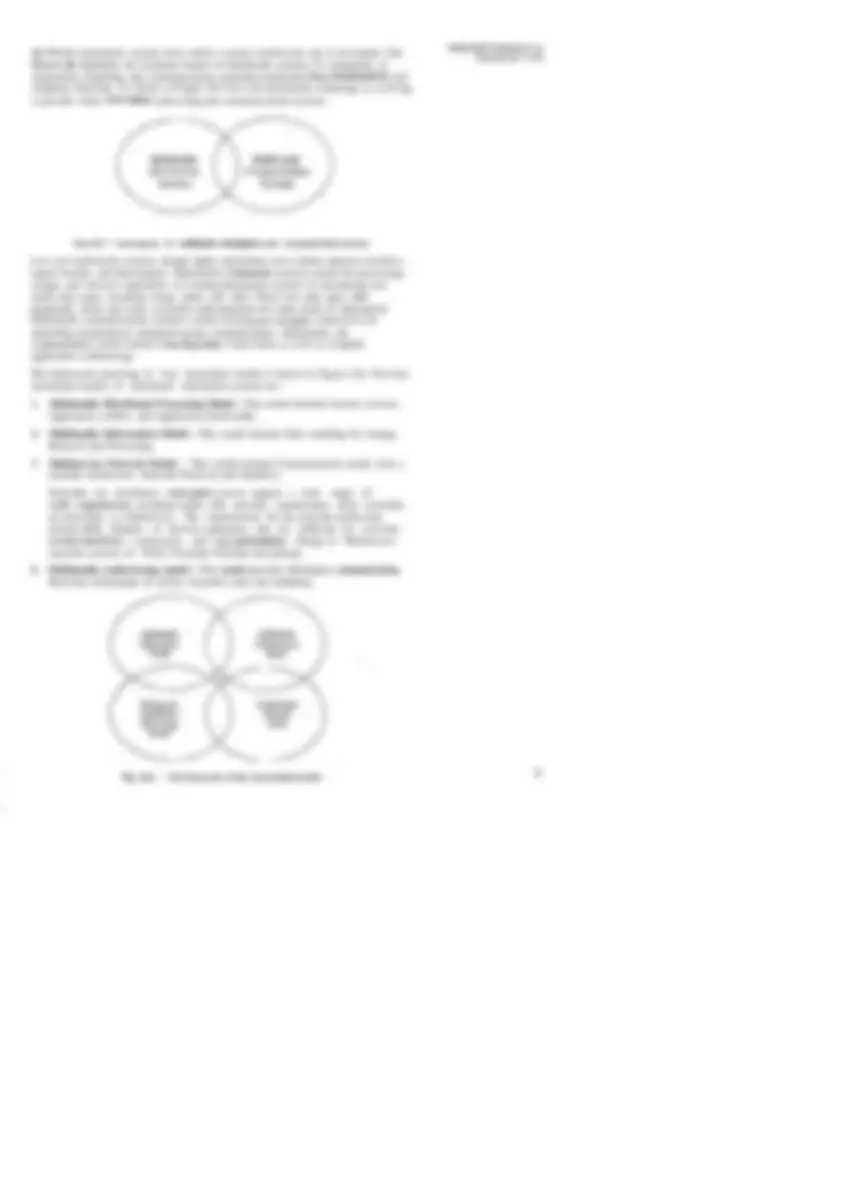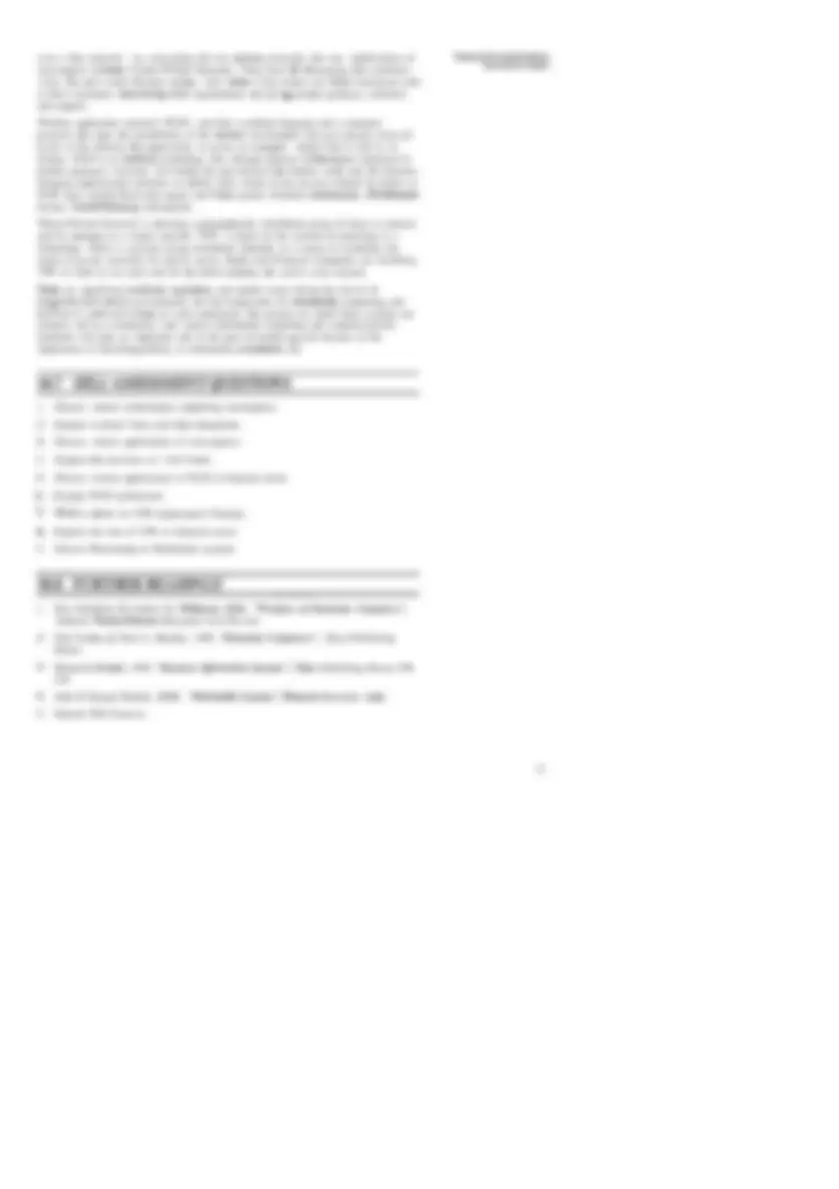














Study with the several resources on Docsity

Earn points by helping other students or get them with a premium plan


Prepare for your exams
Study with the several resources on Docsity

Earn points to download
Earn points by helping other students or get them with a premium plan
Community
Ask the community for help and clear up your study doubts
Discover the best universities in your country according to Docsity users
Free resources
Download our free guides on studying techniques, anxiety management strategies, and thesis advice from Docsity tutors
Unit 10 of Integrated Communication for Banks, focusing on Converged Networks and Wireless Application Protocol (WAP). Learn about the benefits of converged networks, such as voice, data, and video integration, and how WAP enables secure, easy access to internet services for financial institutions and their customers. Discover the role of WAP in m-commerce and its applications in banking.
Typology: Slides
1 / 20

This page cannot be seen from the preview
Don't miss anything!













After studying this unit you should be able to :
voice and data and video at the desktop
architcciure, and its use in banking and finance Understand what are Virtual Private ~ e t w o r k(VPN), its protocols, deployment and its role in financial sector Familiarise what are Multimedia and its application framework in financial sector,
10.1 Introduction 10.2. Convergence of Networks 10.3 Wil.cless Application Protocol 10.4 Virtual Private Networks 10.5 Multimedia Systems
10.8 Further Readings
0. 1 INTRODUCTION
Today's financial business is lechnology driven. Technology is a source of competitive strenglli and is used as a competitive strategy to reach [he custolner at his doorstep. In this scenario, Bank and Finance personnel sliould be aware of technical opportunities in order to meel the customer expectation. The main objective of this unit is to impart the awareness about various technologies and their application in Banks and Financial Institutions.
10.2 CONVERGENCE OF NETWORKS
Thc rlrrival of the Internet has changcd the competitive climate significantly. Reduced harriers to entry have increased co~npetitionwith shorter times to market, new channels of
bank's and financial institutions nced to address two key issues to retain and improve their campctitive position: improve their custo~nerunderstanding and relationship and
Technology changes are enabling businesses to deliver these goals. The Internet has opelied up a whole range of new channels through which customer relationships can be conducted Sroin web enablcd call centers to Interactive TV. Additionally, companies bank'slfinancial institutions are ci-cating sccurc Virtual Private Networks Extranets and extcnded Intranets to providc their partners, customers and suppliers with direct access to specif'ic corporate resources creating new value through an exchange of infonnation. Cuslomers can now use web sitcs to get easier access than ever to infom~ationabout products and services.
telecoinn~unicaLions,and coinputers for the purpose of facilitating new forms of
j
~nli~rrll~t~ion-hascdconi!nercc. Tl~erc:twt, tyi~eso f convergence - lnult~mcdificonvcl.gcncc and cross - media convergence. Mult~mediaconvergellce applies to the conversion of text, voice, data, image, graphics, and full - motion video into digital content. Cross - media rders , to (he integration of various industries - entertainment, publicati (^) o n, and commu~lication media - based on ~ n u l t i ~ n c d i acontent. Convergence of content translates all types of I informalion content - books, business documents, videos, movies, and nus sic - into digital inl'ol.rnaiion. Convergence of t~.ansnlissioncompresses a ~ l dstores digitized information so
clcvices have tlie sol~histicationto function as both computers and televisions. 7'lle Intclnct has opened up the potential for the developmcnt of converged voice and data networlts. Current voice and d:ll.:i sharing technologies keep tlie two separate at application level: you can run voice or data over tlie network hut the user accesses only one. The new gcncration o f applications leverages this ability to combine voice zuld data and video
technologies ancl leveraging the ability to support converged applications at the desktop to i ~ n ~ r o v cboth internal efficiencies and customer communication. Converged networks offer Iiuge c~pportunilicsboth li)r consolidated infrastructure costs within business: the ability to ~ i ~ n l t clong dislancc calls over the Internet is just one exaruple of the way in wllich converged networks arc crcnting a new paradigm for corporate operations. Howcvcr, converged networks bl'ltr so much more than nn opportunity to reduce the costs :wsocialcrl with voice calls. With combinctl voice and daln running across a network, organizntio~islilce hlunl<'s ;111d financial institutions can start to use a new breed of npplic:~tions tli;it sig~lif'ic:i~itlye ~ i l ~ a ~ i c cthe productivity of the individual, applications such as ~~nil'icrl~ncssagingwhich c o ~ n b i n cvoicc, [ax and cmail, ant1 web enabled call ccnters that form a key par1 of the cuslomer tlclivery channel.
Technologies Supporting Convergence Nct\vorlt int'r:~stlucturcsthal were once sepalale and distinct voice and data, wired and wirclcss, p~.c~nisc:incl wide :wen :we ~ncrgingtogelher. Advances in comniunicalions and networking tccl~~iologyarc creating the hnridwidth to ~ n a k ereal convergence practical. Somc o i thcm are :
Optical nctworlcing can carry the entire per sccond tldFic of Internet on single strand of fibct-. In ; u ~cight-ycnr period there would bc n 1,000 - fold incrcase in fiber capacity from 2.5 gigabits lo 400 gigabits LO terabits tloubling (lie amount of embedded fiher. Backbone networks will 1l:unrllc 2,000 times the amount ol' fibel.
access :urangc~ncnt, S o ~ i i cof the applications include the following :
@ LAN-to-IAN hridgcs or routed traffic @ (^) Multi~nedianetworking scrvices set by high sliced devices
Inlroduclions in c(>lnpression technology - most notably xDSL - Digital Subscriber Line - a1.c opening up a wllolc new range of options for peol'le who need multimedia telecom delivered to rcm(ltc oflices. I-IDSL .(High-bit rate DSL) delivers 2Mbps across normal
Integrated C o ~ ~ ~ i r , ~ ~ i r , i. ~. i t , i i Network for Banks
sophisticated services. They are renowned for high quality, reliability, ease of use, manageability, a range of features and billing. Development has been slow as typifies a mature market and the technology devices have been proprietary, further constraining faster development. Data networks typically deliver high speed, fast innovation and rapid price reductions. Data networks are based on open, standard technology which provides easier ~ntegrationof products and supports rapid innovation. Traditionally voice and data networks have been separate. These two separate networks are now conveiging; a move that has been fuelled by the dramatic increase in data traffic that has occurred over tlic past few years. The Internet, together with bandwidth demanding multi - media applications, faster PCs, and faster connectivity, has created a data rich environment. As a result, the telecom~nunicationscompanies are now re - architecting their networks which were initially designed to support the traditional growth patterns associated with voice traffic to meet the huge increase in data. The new high - speed networks being created by the carricrs are
Intcgratcd Comniunication Network for Banks
Voice over IP means that voice calls can be made over a data network, thus converging the two separate networks into one. Voice over IP does not mean tl~atall the calls have to go via the Intcmet and has, - until now, been just point to point co~nmunicationunable to deliver the richness of telephony services which have become integral to the way co~n~nunicationis supported. Call divert, call waiting and caller line irlentification, for example, are important tools. Voice over IP has now come of age, and can dcliver all the richness and functionality associaled with telephony services. On any leased line of an internal WAN connection, 2111 intranet that will support free internal calls using IP can be made functional. However, il is fundamental to re~neniberthat llicre is inorc to
and service provider networlts for voice, data and wireless, and optical.
broadly adopted. Additionally, voice calls can be placcd through tlie Internet via an
only for standard voice calls but also for conference calls and video conl'crencing. Convergence is more co~llplexthan simply running voice over existing data network. Converged nctworks will evenlually be ablc to deliver the sainc rluality and reliability of voice service and they are beginning to move closer to the sound quality that customers have come to expect in the voice world.
Applications of convergence inoludcs the following :
i) Unified^ n~essagingthal^ co~nbillesvoice,^ Ihx^ and e^ -^ mail. ii) Deliver reliable remote access Sol. nlobile einployees. iii) Custo~nerfocused call ccntcrs, integrated with web sites and Intcrtlctive TV to su11pol.t electronic commerce. iv) Voice over IP between branch offices to exploit lower cosl voice and fax calls. v) Virtual Private Networks to link key customers and improve supply chain Management. The above application ability enables organizations to create short and - long tenn architectural and migration plans for voice, data and integrated multi - media networks, focusing on the i~nplementationof convergence solutions to achieve strategic business value. It is sirnply not an option for most o~.ganizationsto abandon today's systems. Indeed, many elements of current network infrastructures will continue to exist and deliver value for some tiine. There will bc many diverse elements to the network of the future: wired,
call centers, wireless co~nmunications,data communications, virtual private networks, e- commerce, Intranets and Extl-a~zets. As the technology develops, so will the networks, for example, @ Voice networks will become more intelligent at handling mixed voice and data calls
En;lblinp '~ccllllolugicsof iVItIder11 Banking
and supporting new server - based productivity applications, such as multi media messaging and Web enabled call centers.
111aking it as easy for individuals to find and communicate with each other through desktop computers as it is to reach cach other on the telephone. And, while cost reductions over initial benefits, cost is not the major issue since cost savings will disappear in the long run as voice tariffs come down. It is important, therefore, that organizations I'ocus on leveraging this technology to improve service through enhanced working practices and delivering overall benefit to customers and e~nployeesthrough applications solutions that seamlessly integrate with legacy systems. Currently technology suppliers are in the process of creating the components of the infrastructure that will support combined voice and data networks. For example, systems are being developed to support combined Local Area Networks (LANs) and telephones from a single connection point to support voice and fax over IP between branch offices.
~ Therefore, vendors are developing producls that will work with an organizations existing infrastructure, delivering gateways that will enable the integration of a legacy Private Brnnch Exchange (PBX), taking voice traffic away rrom the Public Switched Telephone Network (PSTN) and onto an I P based network. This will enable an organization to run voice traffic at a significantly reduced cost lo the traditional PSTN based tariff. This technology can also be used to support inter - office faxing, again reducing eommunicatios costs for an organization. Fax is a good pilot application for this tecl~nologysince quality is not a significant issue. Therc are issues about quality to address, particularly over the backbone, but in the interim it is important that an organization looks for voice ready data products for any new investment in data network technology made to ensure immediate exploilation of the application opportunities prcsentcd by convergence as fast as possible once they arise. Many organizalions wilI opt to use an Internet Service Provider (ISP) to deliver into ofi'ice co~nmunicatioand, with voice requiring high levels of quality and reliability, there
high levels of service.
@ A PC with a modem that supports voice and data or thatis connected to a (^) network
A ~nicrophoneand headset attached to the PC. A separate microphone and speakers can also be uscd, especially for conference calls. 8 The rclevant voice and data transmission software
Once all of these components both backbone and local area - are in place, organizations will begin to start leveraging the technology with applications such as unified messaging which combine voice, email and fax. E-mails can become voice - mails, either using the speaker on the PC or through the telephone, with the option to turn e - mails into faxes to ensure that messages are displayed in the way most suitable for that user at a particular tiinc.
past decade has been the introduction of call centers. The development of Computer
organizalio~~scan hanclle both tele - sales and telephone based customer support. CIT enables customer information to be combined with the telephone call to ensure the operator can deliver high quality customer service through access to up to date, relevant information. The call centers will remain strategically important to customer facing business units despite the emergence of the web as a self - service medium. Self - service media such as tlie web are complementa~yto call centers. Web enabling [he call center can have a direct, positive impact on the customers. The Voice over IP opens up new opportunities for enhancing customer relationships. For
Enabling Technologies Modern Bunking
1
I I i
I
iniranets and ofl'ers the ability to deliver an unlimited range of mobile value - added serviccs lo subscribers - independent of their network, bearer, and terniinal. Mobile subscribers can access the same wealth of info~mationfrom a pocket - sized dcvice as they can access from the desktop. WAP is n global standard and is not controlled by any single company. Ericsson, Nokia, Motorola, and Unwircd Planet founded the WAP Forum in the summer of 1997 with the initial purpose of defining an industry-wide specification for developing applications over
application, session, transaction, security, and transport layers, which enable operators, manufacturers, and applications providers to meet the challenges in advanced wireless service differentiation and fasUt1exible service creation. There we now ovcr one hundred members representing terminal and inl'rastructure manuf'acturers, operators, carriers, service providers, software houses, content providers, and companies developing services and applications for mobile devices. WAP also defines an application environment (WAE) aimed at enabling operators, manufacturers, and content developers to develop advanced differentiating services and
(WWW)-to-mobile-handset messaging, and mobile to tele - fax access. Figurc 10.1 shows a fully functional WAP -enabled devices with lhe main components like Wireless device, WAP gateway and the Internet, whose functions are explained hereunder: Wireless Device : It is a hand- held rnobilc device similar to a cellular phone called WAP phone. Nokia and Ericsson are the few companies who manufacture WAP phones. The WAP phone has a micro - browser and a dialer to dial into a WAP site.
Inter~iet.Generally the gateway is provided by an WAP Service Provider similar to Internet service providers (ISP). The gateway facilitates communication between
systems. Internet : Internet (Inlerconnected Networks) is the Inforniation superhighway network infrastructure. The internet environment is a unique combination of postal service, telephone systenl, researcll library, supermarket, and talk show center that enables people to share and purchase infomatian. Internet provides wide range of computer - based
conferencing. Based on the Internet modcl, the wireless device contains a micro - browser, while content and applications are hosted on Web servers.
Fig. 10.1 : WAP- Enabled Devices
Wireless Service Protocol (WAP) Technology
Internet standards such as Hypertext Markup Language (HTML), HypertcxlTransler
cnntcnt cannot bc d'fectively displayed on the small - size screens oi' pocket-sized mobile
is opli~nizetlfor long latency and low bandwidth. WAP sessions cope with intermittent
Internet access has been limited by [he capabilities of hand held dcvlces and wireless nctwo~ks.WAP utilizcs Internet standal-ds s u c l ~as XML(Extended Markup Language), User Datagram Protocol (UDP), and Internet Protocol (IP). Wileless Markup Languagc (WML), and wireless markup language script (WMLScript) are used to produce WAP content. They make optimum use oS s~nalldisplays, and navigation may he pe~.Sor~nedwith one hand. WAP content is scalable fmrn a two-line tcxt display on a basic dcvice to a ~'LIIIgraphic screen on the latest smart phones and communicators.
subscl of cxlensihlc markup language (XML). Using the same model as the Internet,WAP will cnithlc content and application cicvelopers to grasp the tag-bnsedWML that will pave the way ihr scrviccs to be written and deployed within an operatot's network quickly and easily.
Integrated Con~municntion Network far Batrks
WAP will providc multiple applications, Sor business and customcr markets such as hnnking, corporale datahasc access, :uiJ a ~ncssngingintcrSacc (scc Figure 10.2).
Pig. 10.2 : \VAP/Mobile Dcvicc Display
the WAP gateway (sce Figure 10.3), which is the interface bctwccn (he oper~ritol'snetwork and the Internet.
I Data I 1 Data I ( Sc Encoder I I
The concept of WAP revolves around compressing convergence into one instrument. The ulti~nalegoals of banks will be transactions through various payment channels like credit cards.
result ol' WAP technology - a chance that will impact the look and feel of the hardware thcy produce. The main issues faced by this arm of the industry concern the size of
personal digital assistants (PDAs) and other mobile terminals. The handsets themselves will contain a micro - broswer that will serve to intcrpret the byte code (generated from the WML IWMLS contenl) and display interactive content to the user. The services aveilable to users will be wide - ranging in nature, as a result oC the open specifications of. WAP, tllcir sin~ilnrityto the established and acceptcd Internet model. Information will be available with the ability for users to interact with services via both voice and data interfaces.
Real-time applicalio~lsand services demand s~nalland key pieces o r information that will
travel arc only some of the areas in which WAP will provide services for mobile users. Essentially, the WAP application strategy involves taking existing services that are common within a l'ixcci-line environment and tailoring tlle~nto bc purposeful and user - Sricndly in a wircless environment.
Some ol' the adv;lnlages that WAP can offer are:
O Network - standard independent,
0 Transport medianis~n-opti~nisedfor wireless data.bcarers,
0 Application downloaded from the server, enabling fast service creation, and introduction, as opposed to embedded software. C
Integrated Cctrrtmunicntion Network for Banks.
........................................................................................q.................................................
Enahling Tcchnologics of Modcrn Dunking 10.4 VIRTUAL PRIVATE NETWORKS
W h a t is VPN? ffi Industry vendors and service providers twist and stretch this acronym as needed to fit product offerings. Unfortunately, a single, practical working definition of 'VPN' remains elusive like beauty, the true meaning of VPN is in the eye of the beholder. The goal of all VPN products is to enable deployment of logical networks, independent of physical topology.
and be managed as a single network, extending the end-uscr dynamics of LAN without concern as to the true location of hosts within the VPN. The private part of VPN is - provision of security characteristics such as privacy, integrity, and trust among hosts participating in a virtual network.
ATM networking being considered as VPNs. These typcs of VPNs are generally referred to a Layer 2 VPNs. The emerging form of VPNs arc networks constructed across shared
Generally accepted definition of VPN consists merely of encryption and virtual authentication, but a con~pleteVPN includes the following three critical components: @ (^) Security: Including access control, authentication and encryption technologies to guarantee the security of .network connection, authenticity of users, and privacy and integrity of data con~munications.
based VPN acceleration to guarantee the reliability and performance of the VPN, and, Enterprise Management: Including true policy -based management to guarantee the integration of VPNs within the enterprise security policy, local or remote centralized management of that policy, and scalability of' the solution. The combination of these three components is absolutely necessary to enable practical implementation of Virtual Private Nctworks. In cominon usage a VPN is a group of two or more computers connected together with limited public - network access, that communicates 'securely' over a public network. VPN may exist between
Host - to - host (Server - to-Server). Securiiy features differ from product to product.
I VPN Technology
I
I
the processor overhead on the skrvers.
and routers are implemented within the same organization. These are generally harder to manage than encrypting routers.
I:11:1l>linx icchnr~l(~pirsof 5l11tlcrnBonking
Markct conl~~sionis one reason why many IT managers are opting to outsource all or part of thcir VPNs to third parties. The four elements that are lo be evaluated while outsourcing VPN are - quality of service, reliability, security and manageability. There are rnany factors to consider when evaluating a VPN service, some of them are given below: I. What kind of client will you deploy?
2. What kind of authentication do you do? 3. With rcferencc to POP, what is the port availabilitylreliability? 4. Whal is the server availability'! 5. Wbat is your backbone?
8. Can 1 get a service level agreement (SLA) w.r.t.' performance'? 9. What^ is your^ l~istoryof service outages for the last few months? 10. Who administers client support and help desk'? 1 I. How will you support me in addressing user connection issues'?
The role of VPN in financial sector Networks and comn~unicationsare mission critical. Corporalions, banks and financial insli~utionsdepend on smooth, efficient, reliable voice and dala communications within a site and its customers and suppliers. Such reliance on communications is particularly acute in the branch office of bank's and other organizations. Interacting with customers, supplicrs, and co~npetitors,branch offices are the 01-ganization's link to the outside world. Cuslomcrs, supplicrs, and crnployees depend on the communications facilities of the brunch office. Branch offices need robusl solutions designed for their requirements. Many induslries like bank's and other financial institutions depend on a network of independently owned rcmote offices to generate sales, ensure customer satisfaction, and settlc claims. Bank branches serve as a hub for customer service and salcs outlets, while also serving as a gateway to the financial payments system. For these and many other industries, effective communications have become essential for gaining and sustaining co~npetitiveadvantage. In fact, in response to increased competition in Inany of these industries, banks and financial institutions are decenlralizing key processes and information flows further into their branch office network. Many organizations are moving away from centralized applications and rolling out clientlservcr MIS applications to remote of'iccs, The increased dependence on branch office co~nlnunicatiol~shas become a key IT issue. IT is under constant pressure to lower operating, staffing, and capital expense while providing rock-solid systems. Branch office service and support are
suppol-ting branch offices are expensive tasks. In response to this dilemma, many snloll offices have already bcgun integrating thcir voice and data traffic onto a single "pipe" to reduce access costs. The Internet provides WAN communi~ationsmore cheaply and more
provide .the security, bandwidth, or quality of service (QOS) guarantees which are associated with private networks for which bank's and companies in financial sector are looking forward to. In addition the Internet supports only TCP/IP (Transaction control
Ilence if a corporate or a banks net is run over Internet it costs less but gets an inferior service.
VPN or "extranct" is a technology which serves primarily as a means of extending the ' rc;~chof private nctworks for dial - in access. It provides security, pert'ormbnce, availability, and multiprotocol support ol' a private ne~workovcl- the inexpensive Internet. An important application is connections with customers and business partners for ' companies in financial sector. VPNs may i~ddresslocations where traditional private nctwork connections cannot be economically justifiecl. Trends show that banks and
may be less tlinn half that of a private dial-in access solutions. Bank's and companies in financial sector use in - house communications servers, nod em banks, and toll - free numbers to support dial -in access. Using VPN, banks and financial companies can off - load most of the expenses ancl hassle associated with dial - in connectivity. Users simply dial in to the closest Internet Scrvice Provider(1SP). The ISP manages the modem banks and
the VPN. At the central site like a bank's CorporateIHead ol'l'ice maintains a singlc connection to the Internet, usually via a high - speed digital line. Dial - in traffic looks like ordinary Internet traffic coming in on the Iligh-speed digital access line. Functionally,
users wcre sitting at their desks at the central site. For intra -and intcr-company VPN traffic, considerations such as security, availability, reliability, and perlbr~nancemay force organizations like hank's to consider exactly where their tratfic tlows and what ether traffic uses the same networks. Prlma1.y among considerarions is security. Secul-ity issues includc thc following :
Integrity - Data isn't tampered with Non-repudiation - Senders are who tliey say they are
Except for denial of service all the above concerns can be addressed through encryption and digital kcys. As costs associated with kcys and encryption includes processing powel; network bandwidth, special hardware, and time and cxpertisc to mannge the system organizations like banlts a r e clloosing private networks which are less expensive Lo invest and ach~evea higher level of security as Internet tratl'ic is more vulnerablc for attacks. For instance, if the same physical lines carry Intcrnet and private network traffic, both types of traLfic may be equally vulnerable tq " invasion of privacy " via a network monitor. In this context encrypted VPNs are more secure than private lines.
Activity 3
............................................................................................................................................
1 .........................................................................................................
I Integrated Commur~icntion Network for Uanlts
I. Video - on - demand : The amount of programming available to audiences will increase Integrated^ Cam~nunication
the cable television industry, the telephone industry, and broadcasters to provide greater Ilexibility in what programming is shown and when. The video- on- dernand model takes advantage of some form of two - way com~nunicationbetween the home and the video source, which could he _i_ phone line wilh sufficient bandwidth to carry a compressed video signal. The home may be furnished with a low-cost box, which accepts signals from a hand-held control and which transmits the appropriate status to the video control center. The viewer uses the hand- held control to navigate a selection menu and choose a program. Shortly after the seleclion is made, the program begins playing. During the course of the movie the viewer is able to pause, reposition, and use other VCR - like control.
Home Shopping
their telephone and using thcir 'credit cards. Two po'ssible directions that this application might take are:
Healthcare Multiinedia technology permits visual data to be more easily viewed, shared, and processcd. Environments in which imaging applications are proxnincnt are good candidates for use of rnultimcdia technology. Certain segments of' the health- care industry are exatnples of this, and several systems involving rnultimcdia cornmunications
(Magnetic Resonance Imaging), etc. is growing in healthcare. The collection, maintenance, processing, and distribution of these records can be significantly improved by using computer- based storage and high-bandwidth coinmunications. Once these records are integrated with the on - line patient information and easily shared by both local and remote physicians, a large number of benefits result in reduced costs and irnproved care. Major hospitals can use high - bandwidth communications from smaller hospitals to increase referrals to conlplex procedures and atlract wider usage of advanced facilities.
hospital and the client hospitals, which become more dependent on the higher - quality service.
particularly valuable for complex treatments. Information sharing and video confciaencing are key components of multiinedia communications.
Education 'The ability of multimedia inaterials to convey by picture, sound, animation, or movie what is otherwise hard to express, to capture for reuse on any occasion remote lands, and
ISnehling 'l'cchnolugies of (^) singular events, and with the use of the cornputel; to provide the information in a form hlodcrn Ili~nking (^) that can be engagingly interactive and easily recast by ally aspiring communicator is the
explanation for the popularity and particularly long history of multimedia technology's
Educational titles have been one of the dominant product areas for multimedia computing. Generally educational multimedia software contains a database (stored on videodisc) having many collections with variety of cultul.al, historical, and scientific themes; the total database consists of several media objects, with accompanying keywords, citations and descriptive material. Specific tools for searching, cditirrg; and-composing, with the media objects as the raw materials, are included with the software.
Engineering The new multimedia technologies are leaving their marks not only in public but also in industrial applications, for example process control systems. Tele - commissioning, tele- operation and tele -service based on multimedia user interfaces are of growing importance in automation and process control engineering. The method to accelerate the design and manufacture of complex systems and products is known as concurrent engineering. One of the key precepts of these practices is the coordinded activity of engineering, manufacturing, and management activities of a project thorough all phases of its development. The benefits of this approach are reduced time-to- ~tlarkctand improved product quality. The use of n~ultimediacommunic;ltions tools is one of two uses of multimedia technology that play an enabling role for concurrent engineering. Tliese tools permit prodi~ct groups to co~nmunicatein distributcd environments, sharing application and data, using on - line group decision support tools, and interacting i n group conference calls. Engineering and manufacturing groups rely increasingly on CAD (Computer Aided Design) and CAM (Co~nputerAided Mauulhcture) software to design, manufacture and maintain their products. Together with technical publishing software, these tools permit design specifications and technical documentatio~~to be created and accessed on - line. The second enabling role of ~nultimediatechnology is to supplement these existing tools with a richer information processing environment. For example audiovisual product information, voice annotations of design documentation, and on - line interactive help manuals can be supported by the availabilily of on-linc multimedia information. The richer info~lnationcontent indirectly enables the concurrent engineering process by
concurrent engineering can be enhanced by use of computer and communication
richer information environment. The distributed multimedia workstation environment colnbines a cross - campus video network, existing applications software, and shared applicalions to allow multimedia documents to be shared during group video conferences. The two roles of inultimedia technology in concurrent engineering are : Q) Engineering and manufacturing as a visually rich domain is a natural beneficiary of multi~nediainformation processing. @ Group comn~unications,when conducted via thc computer workstation, allows the participants to refer to and share any on - line materials that might be appropriate to the discussion.
Multimedia application in Finance and Ranking, touchscreen kiosks have entered the business. More number of banks as part of e- banking are setting up touchscreen kiosks at places such as impel-tant corporate centers, retail supermarkets, air - ports etc, A crucial advantage of multimedia technology is the shift to visually oriented interface. Replacing tables and text with pictures can make the infomation and the interaction process more direct for users.
Framework for Multimedia Systems The framework of Multimedia systems is an overall picture of the development of
Enahling Technologies il, In the figure 10.6 the information model and distributed processing model are^ thc^ two 4otlern Banking (^) components of Multimedia Information system (MMIS).
Multimedia conferencing, as a technology for supporting communications with multiple parties and media, is more than an evolution of traditional specialized teleconferencing systems. Video teleconferencing uses dedicated equipment and line, specially designed conference rooms, and a range of video qualities in which motion artifacts and audio delays were common. These systems arc typically used by large organizations like banks
geographically distributed sites. Tlle investmelit in conferencing equip~nentcould be justified by the increased organizational interaction and the reduction in travel expenses. Conferencing systems are frequently used for point-to-point conferences between predefined locations. Conferences were typjcally scheduled ahead of time. Participants went to specifically configured meeting rooms to attend conference and videophones.
.............................................................................................................................................
3. What are the four interrelated models of Multimedia?
10.6 SUMMARY
telecommunications, and computers for the purpose of facilitating news fonns of information-based commerce. There are two types of convergence - multimedia convergence and cross - media convergence. Multimedia convergence applies to the ,conversion of text, voice, data, image, graphics, and full-motion video into digital content. Cross - media refers to the integration of various industries-entertainment, publication, and communicatioi~media-based on multimedia content. The Internet has opened up the potential for the development of converged voice and data networks. Converged networks offer huge opportunities botli for consolidated infrastructure costs within business: the ability to make long distance calls over the Internet is just one example of the way in which zonvcrged networks are creating a new paradigm for corporate operations. There are various technologies supporting convergence namely Optical technology,
technology etc. Traditionally voice and data networks have been separate. These two separate networks are now converging; a move that has been fuelled by the dramatic
with bandwidth demanding multi-media appUcations, faster PCs, and faster connectivity,
over a data network, ~ h u sconverging the two separale networks into one. Applications of Integrated^ Com~nun!ieatioin
voice, Fax and e - mail, Remote acccss, Call cenlers. Call centers are where businesses talk to their customers, discovet-ing thcir requirements and giviqg proper guidance, solutions and support. Wireless application protocol (WAP) provides a markup language and a transport protocol that open the possibilities of the wirelcss environment and give players from all
infancy. WAP is an cnabling technology that, through gateway infrastruclure deployed in mobile operator's network, will bridge the gap bctwecn llie mobile world and the Internet, bringing sophisticated solutions to mobile users. Some of the services offered by banks to WAP users include Real - time equity and Forex quotes, Portfolio Inforn~ation,ATMIbranch locator, Travel~Ticketinginformation.
and be managed as a single network. VPN is based on the concept of tunneling is a
reach of privatc networks for dial - in access. Banks and Financial companies are installing VPN in order to cut costs and for irs robust sccurity and pcrlormancc reasons. Tlicrc arc significant tcchnical, regulatoiy, and market issues facing the arrival of intcgratcd multimedia environments, but the frameworks for multiinedia computing and n~ul!i~nediacon~~nunicationsarc well understood. The process by which these systems are realized will he evolutionary, and various multimedia computing and communications standards will play an important role in the pace of market growth because of the importance of interchangeability to multimedia informati011 use.
10.7 SELF ASSESSMENT QUESTIONS
10.8 FURTHER READINGS'
Addison WesleyIPearson Education Asia Pte Ltd.
2. Pete Loshin & Paul A. Murphy, 1999, " Electronic Commerce " , Jaico Publishing House. 3. (^) Muneesh Kumar, 1998, " Business Infornzation Systems", Vikas Publishing House Pvt. Ltd.